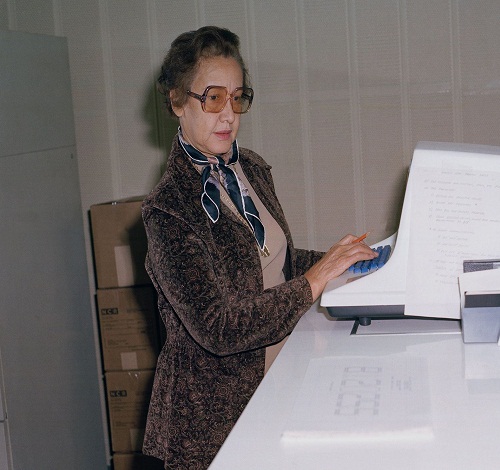Katherine Johnson, the former NASA mathematician depicted in the 2016 film “Hidden Figures” about black women who helped pave the way for astronauts to reach the moon, died Monday, the space agency announced. She was 101.
“Mrs. Johnson helped our nation enlarge the frontiers of space even as she made huge strides that also opened doors for women and people of color,” NASA Administrator Jim Bridenstine said in a statement.
“Her dedication and skill as a mathematician helped put humans on the moon and before that made it possible for our astronauts to take the first steps in space that we now follow on a journey to Mars,” he added.
In 2015, then-President Barack Obama awarded Johnson the Presidential Medal of Freedom. The following year, he cited her in his State of the Union Address as an example of the country’s spirit of discovery.
During NASA’s early years, Johnson and her black colleagues were referred to as “computers” — people who performed computations – and toiled anonymously behind the scenes.
When the Oscar-nominated movie — in which she was portrayed by Taraji P. Henson — hit the screens in 2016, the women gained long-overdue attention.
During the Academy Awards ceremony in 2017, Johnson was given a standing ovation when she joined the film’s cast in presenting an award for documentaries.
During her stellar 33-year career at NASA, Johnson worked on the Mercury and Apollo missions — including Apollo 11’s first moon landing in 1969, when Neil Armstrong became the first human to walk on Earth’s satellite.

John Glenn, one of the famed Mercury Seven spacemen, thought so highly of Johnson that he insisted that she be consulted before his mission aboard Friendship 7 on Feb. 20, 1962.
“Get the girl to check the numbers,” said Glenn, who became the first American to orbit the globe.
“He knew I had done (the calculations) before for him and they trusted my work,” Johnson, who continued her work during the early years of the space shuttle program, told the Washington Post in 2017.
Johnson was born Aug. 26, 1918, in White Sulphur Springs, West Virginia, to a teacher and a farmer, both of whom stressed education and moved the family 120 miles to a town that had a high school for black kids.
Thanks to her astounding math skills, Johnson was accepted into West Virginia State College when she was just 15. She earned degrees in math and French before becoming one of the first black students in the graduate school at West Virginia University in 1938.

After working as a schoolteacher for seven years, Johnson went to work for the National Advisory Committee for Aeronautics, a NASA forerunner in 1953 along with dozens of other black women.
During the space race between the US and the former Soviet Union that began in the late 1950s, Johnson and her colleagues used pencils, slide rules and rudimentary calculators to crunch numbers for unmanned rocket launches.

They worked in facilities separate from their white counterparts, though Johnson always maintained said she was too busy to be concerned with racism, according to Reuters.
The orbital mechanics guru was part of the team that supported Alan Shepard, who became the first American to reach space on the 15-minute suborbital flight aboard Mercury’s Freedom 7 on May 5, 1961.
“She didn’t close her eyes to the racism that existed,” Margot Lee Shetterly wrote in “Hidden Figures.”
“She knew just as well as any other black person the tax levied upon them because of their color. But she didn’t feel it in the same way. She wished it away, willed it out of existence inasmuch as her daily life was concerned.”
Johnson and her first husband, James Francis Goble, who died of a brain tumor in 1956, had three daughters. In 1959, she married US Army Lt. Col. James Johnson, a veteran of the Korean War.
Source: Nypost











